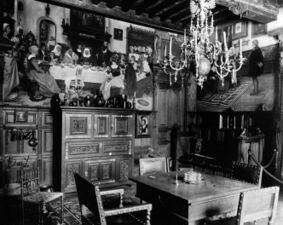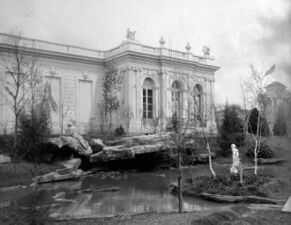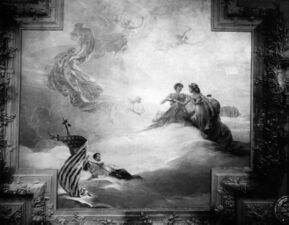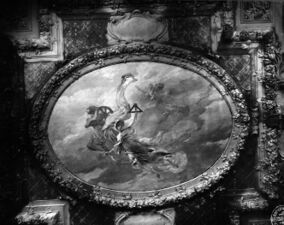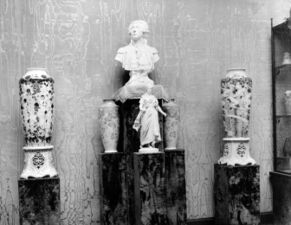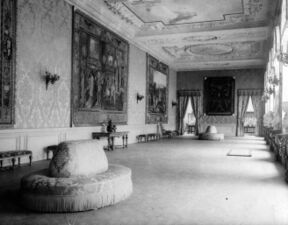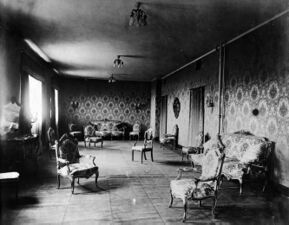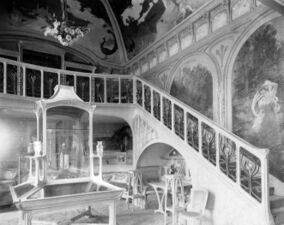France
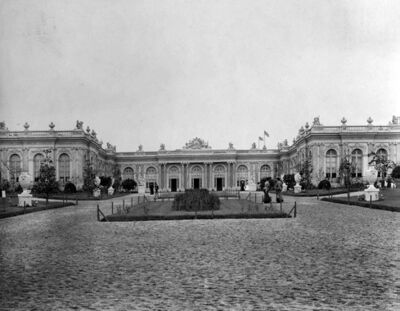 | |
| Location | Place of Nations |
|---|---|
| No. of Buildings | 1 |
| Construction | |
| Construction Cost | $142,000 ($4.28 million in 2021) |
| Dates | |
| Dedication Day | May 16, 1904 |
France's National Pavilion at the Louisiana Purchase Exposition was a 15 acre replica of the historic Grand Trianon at Versailles during the reign of King Louis XIV. It was situated on Forsythe Ave., (also called the Olympian Way).
Description[edit | edit source]
The pavilion consisted of a central building, flanked by two wings that terminate each in a pavilion. The latter was united by 22 Ionic marble columns of red and green. The roof was surrounded, in Roman style, by a balustrade, ornamented with vases and beautiful groups of figures. Corresponding balustrade extended along the front below, in the center of which stood a massive yet handsome iron gate opening to the principal entrance. The entire front measured 534 feet.
The Grand Trianon was one of the favorite residences of Napoleon, and its grand design and extensive grounds and gardens was reproduced quite well with striking results.
A broad driveway led up a gentle slope to the court of The Trianon pavilion. The 15 acres were beautifully cared for and included ponds, and gardens. The pavilions huge grounds contained reproductions of several beautiful chalets of Marie Antoinette.
The building was open to visitors with passes daily, except Wednesday, from 9 am. to 6 pm., and to others on Tuesdays, Fridays and Saturdays from 2 pm. to 5 pm.
The exterior staff was stained artistically to imitate pink-veined marble.
On the ground floor were apartments as well as a picture gallery and the billiard room. In one display case was a lock of Napoleon's hair.
The right wing had three rooms filled with the exhibits of the City of Paris, including engravings of the masterpieces which decorated the City Hall of Paris. Two rooms were filled with a splendid exhibit of porcelains and bisques from the porcelain factory of Sevres, including a statue of Lafayette by Houdon. The ceilings of the galleries d'honneur, at the rear, were ornamented with three great paintings, typical of Liberte, Bgalite and Fraternities. Large gobelins (tapestries), of the period of Louis XIV. decorated the wall.
Many fairgoers marveled at the scale and spender of the salons (massive rooms with ornate paintings, frescos and ceiling art). The salons included rare and decorative vases, statues, jewelry, glasswork. Another showcased an exhibit of the Chamber of Commerce of Paris.
Gardens[edit | edit source]
A grotto was constructed to represent the outcropping of a ledge of limestone. Bridges lead from an island to the main land. Several works of art in sculpture are distributed about the garden. One is a “Lion seated on its Haunches", done in pink marble. “The Minuet” is a bronze. “The Girl with Flowers” is a white marble. Espalier fruit trees are the common fruit trees pruned and trained to assume strange forms. They are made into pyramids, spindles, vases and other forms. The apple, the pear, the peach, the apricot, the plum, are thus trained. Some of the espalier trees in the garden of France represent ten years training with the frame and the knife. Many varieties of roses and evergreens and other shrubbery were brought from France. With sunken logs the gardener has produced different levels in the surface of the garden.
After the Fair[edit | edit source]
Gallery[edit | edit source]
-
Ante Room
-
Artificial Lake
-
Ceiling Fresco
-
Ceiling Fresco
-
Cloisonné
-
Gobelin Room
-
Parlor
-
Stairway
